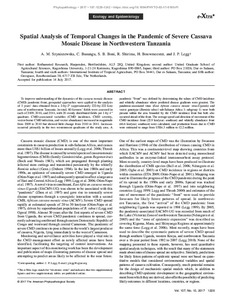| dc.contributor.author | Szyniszewska, A.M. |
| dc.contributor.author | Busungu, C. |
| dc.contributor.author | Boni, S.B. |
| dc.contributor.author | Shirima, R. |
| dc.contributor.author | Bouwmeester, H.J. |
| dc.contributor.author | Legg, J.P. |
| dc.date.accessioned | 2019-12-04T11:10:24Z |
| dc.date.available | 2019-12-04T11:10:24Z |
| dc.date.issued | 2017-10 |
| dc.identifier.citation | Szyniszewska, A.M., Busungu, C., Boni, S.B., Shirima, R.R., Bouwmeester, H. & Legg, J.P. (2017). Spatial analysis of temporal changes in the pandemic of severe cassava mosaic disease in North-Western Tanzania. Phytopathology, 107(10), 1229-1242. |
| dc.identifier.issn | 0031-949X |
| dc.identifier.uri | https://hdl.handle.net/20.500.12478/2126 |
| dc.description | Published online: 8 Sept 2017 |
| dc.description.abstract | To improve understanding of the dynamics of the cassava mosaic disease (CMD) pandemic front, geospatial approaches were applied to the analysis of 3 years’ data obtained from a 2-by-2° (approximately 222-by-222 km) area of northwestern Tanzania. In total, 80 farmers’ fields were assessed in each of 2009, 2010, and 2011, with 20 evenly distributed fields per 1-by-1° quadrant. CMD-associated variables (CMD incidence, CMD severity, vector-borne CMD infection, and vector abundance) increased in magnitude from 2009 to 2010 but showed little change from 2010 to 2011. Increases occurred primarily in the two westernmost quadrants of the study area. A pandemic “front” was defined by determining the values of CMD incidence and whitefly abundance where predicted disease gradients were greatest. The pandemic-associated virus (East African cassava mosaic virus-Uganda) and vector genotype (Bemisia tabaci sub-Saharan Africa 1–subgroup 1) were both present within the area bounded by the CMD incidence front but both also occurred ahead of the front. The average speed and direction of movement of the CMD incidence front (22.9 km/year; southeast) and whitefly abundance front (46.6 km/year; southeast) were calculated, and production losses due to CMD were estimated to range from US$4.3 million to 12.2 million. |
| dc.description.sponsorship | Bill & Melinda Gates Foundation |
| dc.description.sponsorship | Biotechnology and Biological Sciences Research Council, United Kingdom |
| dc.format.extent | 1-14 |
| dc.language.iso | en |
| dc.subject | African Cassava Mosaic Virus |
| dc.subject | Diseases |
| dc.subject | Cassava |
| dc.subject | Food Security |
| dc.subject | Pandemic |
| dc.subject | Spatial Analysis |
| dc.subject | Geospatial |
| dc.title | Spatial analysis of temporal changes in the pandemic of severe cassava mosaic disease in Northwestern Tanzania |
| dc.type | Journal Article |
| dc.description.version | Peer Review |
| cg.contributor.crp | Climate Change, Agriculture and Food Security |
| cg.contributor.crp | Genebanks |
| cg.contributor.crp | Roots, Tubers and Bananas |
| cg.contributor.affiliation | Rothamsted Research |
| cg.contributor.affiliation | Kagoshima University |
| cg.contributor.affiliation | International Institute of Tropical Agriculture |
| cg.contributor.affiliation | Geospace, Netherlands |
| cg.coverage.region | Africa |
| cg.coverage.region | East Africa |
| cg.coverage.country | Tanzania |
| cg.isijournal | ISI Journal |
| cg.authorship.types | CGIAR and developing country institute |
| cg.iitasubject | Cassava |
| cg.iitasubject | Climate Change |
| cg.iitasubject | Plant Diseases |
| cg.journal | Phytopathology |
| cg.howpublished | Formally Published |
| cg.accessibilitystatus | Open Access |
| local.dspaceid | 90656 |
| cg.targetaudience | Scientists |
| cg.identifier.doi | http://dx.doi.org/10.1094/phyto-03-17-0105-fi |

